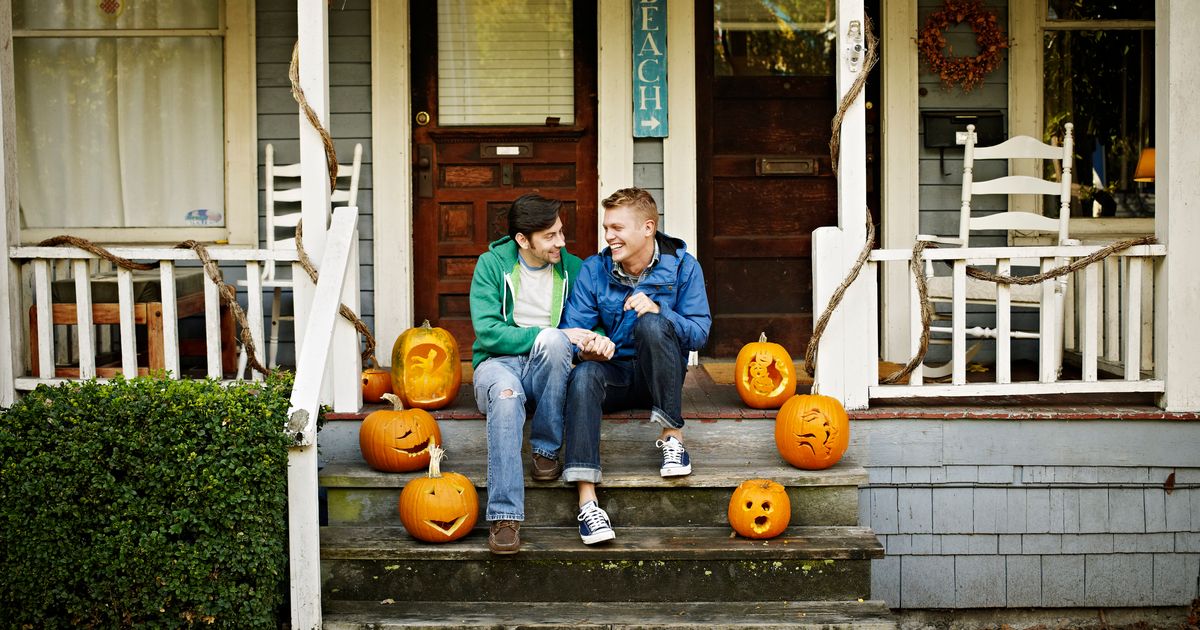Have you ever just looked at a display of pumpkins, gourds and Halloween lights at a neighbor’s house (or even in your own home) and felt instantly happier? Well, there’s a scientific explanation for that.
Joy doesn’t have to come from big gestures or monumental days; it can come from little moments, too. It’s important to have things that we find pleasurable incorporated into our lives throughout the year, said Dr. Elaina DellaCava, a psychiatrist at New York’s Weill Cornell Medicine and NewYork-Presbyterian Hospital.
For many people, one of those pleasures is the simple act of decorating for fall. Experts told HuffPost why decorating for the season may benefit your mental health.
The colors of fall can evoke happy feelings.
“Colors can influence our mood and can actually create a surge of dopamine, which is our happiness hormone,” DellaCava said.
A 2020 study found that the color orange ― often seen in popular fall decorations like pumpkins, autumn leaves and Halloween string lights ― is more associated with joy and overall positive feelings. So, those pumpkins on your table may actually make you happier when you catch a glimpse of them.
The same research also showed that yellow, another popular color for fall home decor, is associated with feelings of joy and amusement.
Traditions can remind us of good times and give us something to look forward to.
Whether you realize it or not, decorating for fall every year means that you officially have a decorating tradition. And this is a good thing for your mental health.
“Traditions give us something to look forward to,” DellaCava said.
In general, she noted, traditions are often associated with feeling close to family or friends. (Examples might include your Friendsgiving celebration or apple picking with your kids.) Annual decorating may connect you with neighbors who are doing it as well, or it may even be a fun yearly activity for your family or roommates.
These traditions can also be something that you’ve carried on from your childhood and call up memories of an innocent, fun time in your life, when you would go trick-or-treating with friends or carving pumpkins with siblings.
“Decorating for fall is a way to reconnect us with that part of ourselves,” DellaCava said.
And traditions can create some predictability in an unpredictable world.
The point of a tradition is that it happens at the same time every year. So, traditions give us a sense of predictability in our lives — but in an exciting way, DellaCava said.
Kim Gorgens, a clinical professor in the Graduate School of Professional Psychology at the University of Denver, added that humans are habitual creatures who thrive on control.
“The illusions we have about having control over every controllable aspect of our lives really fuels mental stability,” Gorgens said.
Ultimately, we have very little control of our lives, she added — you can’t dictate major things like health issues or layoffs — but our physical environment plays a large part in our perception of control. In other words, we can control the organization of our kitchen cabinets or, in this case, the decorations we put on the windowsill.
Additionally, when we decorate at a certain point every year, we feel in control of time in relation to that activity, Gorgens added.
fotostorm via Getty Images
Decorating for fall allows us to benchmark our time.
Between back-to-school season and the end of beach vacations, fall signifies a new chapter for many people. But adults who are no longer in school have little to mark this change.
“There are interesting models of why time feels like it goes so much faster as we get older, and one of the explanatory models is we lose benchmarks,” Gorgens said.
As children, we get to look forward to learning to drive, getting to vote or being old enough to drink alcohol. “We have all of these big developmental milestones, and then we lose that,” Gorgens said.
This is where the seasonal decor comes in. “Fall is one way we are benchmarked to the passage of time,” Gorgens added.
And beyond just a change in the weather, having your home reflect the new season makes it much more of a benchmark.
Fall decorations give us a reason to celebrate our homes.
“We’re not unlike other mammals who make a den,” Gorgens said. “We are really invested in our space.”
What’s more, having a home, particularly a safe home, plays a huge role in our mental health, she noted. This goes back to psychologist Abraham Maslow’s hierarchy of needs, a theory about how certain fundamental necessities dictate our motivation and behavior. In this hierarchy, “the most important foundational component of well-being is having a safe home space,” Gorgens said.
So, when you have a home base (whether that’s a house, apartment, bedroom or other space), being able to decorate it for the time of year is a way of — knowingly or not — celebrating that place.
For those who recently left an unsafe situation, decorating their own space can be a crucial way to celebrate that victory, Gorgens added. This also rings true for anyone who recently purchased a home or moved into their first apartment.
“It’s a way of making really obvious the emotional investment you make in a home,” Gorgens said.
Between the pandemic and colder weather, we’re home more during the fall, which puts more importance on our space.
“Since the pandemic started, a lot of us are spending even more time [at] home,” DellaCava said, referring to the COVID-19 crisis. We’re working from home, commuting less and traveling less.
Plus, the days are shorter in the fall, so you’re more likely to be home in the evenings, DellaCava noted.
“More than ever, it’s helpful if our home feels like a place that feels relaxing, comfortable … [and] inviting,” she said.
When you decorate your space in a way that’s visually appealing, it will help your mood — especially when you’re stuck at home and dealing with loneliness or anxiety (two feelings that can come with the arrival of an earlier sunset).
“Decorations can make you feel connected with times you remember fondly, and that can help your mood and general sense of well-being,” DellaCava said.
In the end, going home to a cheerful space will only help your emotional well-being.
But with less sunlight, fall can be a tough time for many.
Seasonal affective disorder impacts millions of people every year. And while it exists in the spring and summer, it’s more associated with the fall and winter — seasons with fewer hours of sunlight and a higher production of the sleep hormone melatonin in our bodies.
If you have a hard time feeling excited about the arrival of fall, try to celebrate the season from time to time, Gorgens said. Practicing mindfulness, celebrating change and benchmarking the passage of time are all expert-backed recommendations for people who have difficulty with the colder seasons, she added.
For you, celebrating the season could mean sitting down with a mug of tea and your favorite movie. Or, it could mean putting on your favorite fleece sweatshirt and heading out for an autumn hike. You don’t necessarily have to put up ghostly decor for Halloween or adorn your stoop with pumpkins. Whatever it means to you, leaning into the season can make the shift a little easier, Gorgens noted.
Additionally, if you notice that your mood is consistently lower throughout the season and a cup of tea or fall hike isn’t helping, reaching out to a therapist could be a good idea, DellaCava stressed. And if you usually look forward to decorating for fall but can’t be bothered this year, that could also indicate a need to talk to someone.
For some people, the arrival of this new season is exciting, but for others, it’s a hard time of year. Just remember that there is help out there for those who need it.


